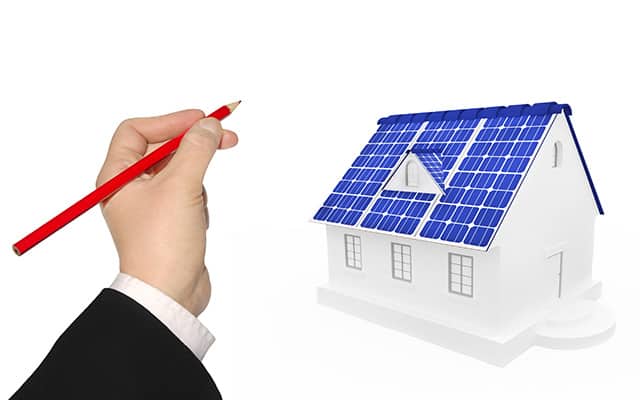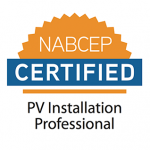[masterslider_pb alias=”ms-15″]
Why not join thousands of others who are generating their own power and have used the Promsun Experts. All you have to do is fill out the contact form at the top of the page and compare costs among trusted installers in your area.

Photovoltaic Technology
What is a Photovoltaic System?
Also referred to as a Solar Photovoltaic (PV) Power System, it’s designed to supply solar power through photovoltaics, which is a method for converting solar energy directly into electricity.
Do I need Batteries for a Photovoltaic System that connects to a Utility Line?
Photovoltaic Systems that rely on utility power lines, or the grid, do not need batteries, the system comes with everything needed.
Do I need Batteries for a Photovoltaic System that are Off-Line?
For off-grid systems, batteries will be required to produce power, especially if you live in an area that frequently experiences power outages. You can find more information about how Solar PV Systems operate with and without utility power lines on our website.
Energy Production and Cost Savings
How much electricity will my system provide each year?
An average residential solar system, at peak effectiveness, will give you up to 8,200 kWh per year. Solar panels will help reduce your electric bill by approximately 50%. You may also earn money through the government’s feed-in tariff.
What's the output of an average solar panel?
Each solar panel system is different. In order to give you an idea of the different costs, let’s look at average domestic solar panel systems:
Domestic solar systems lean toward a range of 1 kilowatt to 5 kilowatt in size. Typically, a 1kW solar system will generate approximately 1,700kW and a 5kW will generate approximately 8,200kW.
So, how does this energy breakdown in reference to power?
A 2 to 3kW solar panel system is only good for a smaller home. While a 4 or 5kW solar panel system is plenty of energy for a family sized home. Your average 5kW system will generate approximately 8,200kW of electricity per year.
What factors come into play for the amount of electricity I will produce?
Due to the constant rise in energy bills, more homeowners are opting to install solar panels. This is not surprising as the average home can reduce their bills by approximately 50%. Adding to that, you will receive tax free cash payments over the next 20 years through the Government’s Feed-In Tariff.
There are some major factors that have to be taken into consideration when calculating how much electricity will be generated through solar panels:
-The Size of the Solar Panel System:
The average domestic solar panel system ranges from 3kW to 5kW. The size that is best for you depends on your energy requirements. The larger the system, the more energy will be generated. We estimate an average 3 bedroom home, in the USA, will use a little over 4,000kW per year. Therefore, in theory, a 5kW system is capable of producing electricity to your entire home.
-The Direction & Angle of the Roof:
The direction and angle of your roof will effect the amount of electricity your solar panels will generate. Ideally, your roof should face South, South-West or South-East because the “south” factor is where the sun is in the sky the longest hours during the day. (East and West can also work) For the best results, your roof’s angle should be between 10 to 60 degrees.
-Shading:
The amount of shade that covers your roof should also be taken into consideration. Shading has an effect on the amount of electricity your system will be able to generate. If your roof is continually in shade, a solar panel system will probably not work for you. If your shading only happens in the early morning or late evening, solar panels will generate an acceptable amount of power.
-The Time of Year:
This also has an impact on the level of electricity your panels will generate. Solar panels do produce energy year round, even during the winter months. Solar panels work with light not heat, making the USA climate an ideal place.
Keep in mind, the shorter the daylight hours are in the winter months, the less the solar panels will generate energy vs the summer months. If you are unsure whether your property is good for solar panels, you can use a very unique device known as a solar panel calculator. You will be able to calculate how much energy your property will generate.
How will I know how much electricity my solar panels will generate?
Your solar panels will come with a meter that will be placed in a handy location within your home. The meter will record the amount of electricity being generated by the solar panels. It will also show how much electricity is exported back to the grid. This will give you a good idea how much you will be paid through the Government’s Feed-In Tariff.
Solar manufacturers are developing online monitoring tools that will allow you access to your solar panel’s performance via your computer or smartphone app.
Do I have to perform monthly or yearly maintenance on my system?
Solar panels require virtually no maintenance, while automatically powering your home with free electricity. It can make it very easy to totally forget about it. We do, however, recommend that you check your meter on a monthly basis to ensure everything is working properly.
How To Use Your Electricity Intelligently?
In order to get the most out of your electricity, you want to use some common sense when operating appliances such as your dishwasher, washing machine and vacuum cleaner. You should run these items during the day when the panels are generating the highest level of energy.
To be as energy efficient as possible, here are a few steps to take into consideration. Use energy saving bulbs, only boil as much water as you will be needing, make sure devices (not in use) are turned off and only run your washing machine with a full load.
Who bears the cost of interconnection?
For private individuals living in municipal areas with their utilities below 20kW, interconnection is absolutely free. Also, there will be no interconnection or application fee. You will only be charged when buying a new electric meter, or upgrading any of your distribution system.
How do I secure a net-metering agreement?
With a net metering system, you can conveniently measure the amount of electric power produced by your solar system, and also the amount of energy you consume. This ensures you don’t pay for what you don’t use.
Solar PV System Size
What size system do I need for my home or business?
Three core factors affect the sizing of your system: your electricity usage, space availability on your property, and your budget.
What size solar energy system is right for your home?
The average domestic solar panel system ranges from 3kW to 5kW. The size that is best for you depends on your energy requirements. The larger the system, the more energy will be generated. We have estimated that an average 3 bedroom home, in the USA, will use approximately 4,000kW each year. Therefore, a 4 to 5kW system is the correct choice for this size of home.
What is a decent sun powered site?
A decent rooftop for sun oriented would be unshaded and facing south. The rooftop ought to be in decent shape and generally new, as our modules have an execution guarantee of 25 years. Contingent on framework size, you will require somewhere around 200 and 700 square feet of unhampered rooftop range (clear of dormers, smokestacks, and so on.). On the off chance that a rooftop mount is not down to earth, a ground mount at some sunny spot in the yard is an alternative.
Ground mounts are frequently more proficient than rooftop mounts, since they can be introduced at the ideal pitch and insolation; be that as it may, they require a structure to mount the modules on.
What Makes a Good Location for a Solar PV System?
• A rooftop confronting south, southeast or southwest – Although a rooftop is the best area, a ground-mount system can likewise be introduced if a rooftop can’t be utilized.
• A 35 to 50 degree rooftop tilt –This considers ideal year-round energy generation. A Solar Panels can likewise be set on a level rooftop utilizing a racking framework.
• Adequate space on your rooftop or property.
• Clear access to the sun for a large portion of the day – The area ought to be unhindered by trees, rooftop peaks, fireplaces, structures and different elements of your home or encompassing scene.
• A rooftop in great condition – If your rooftop should be replaced in the exact not so distant future, you might need to replace your roof before going solar.
Where can my Solar Panels be mounted?
Certain guidelines must be checked in order to determine whether the building is a good candidate for a photovoltaic installation. The first step is to check whether the building receives enough sunlight from 9 a.m. to 3 p.m. In spite of the fact that an insolation of roof facing south is ideal, a deviation of 30 degrees or less from genuine south is still good for solar panels. The favored rooftop slant is 35 degrees in Northeast area however rooftop slants somewhere around 20 and 50 degrees (about 4/12 to 14/12 pitches) are satisfactory. Next step is to check what is the age of the roof. Replacing the roof is associated with removing the solar panels and then re-installing them which can be quite expensive that’s why the best scenario is when the remaining life of the roof will coincide with the lifetime of the PV system.
In order to determine a good location for a photovoltaic installation please refer to the subsequent information provided on our website.
Do the Solar Panels should be mounted on the Rooftop?
No, Solar Panels can likewise be installed on a ground mount if an unshaded territory is accessible.
Solar PV System Installation
Do I need a New Roof?
For the reason that your solar system is designed and manufactured to last a minimum of twenty five years (and many will last ever longer), your roof should be in a good condition with at least ten years of its useful life left. An important part of your system cost will be in the installation of the panels, so if you plan on changing your roof in the next five to seven years, consider doing that first. Or else, your installer will need to come back to remove the panels and reinstall them on the new roof. So, if you are not sure about the structural integrity of your roof, have it efficiently inspected to confirm its suitability and condition.
How much space do I require for mounting a PV System?
Rooftop Solar PV system needs 100 – 140 sq. ft. of shade free roof space per kilowatt (kW) of electricity produced. Module efficiency is directly linked to the generated power therefore, we can assume 10-12 watts per square foot. In other words a typical solar installation for your home will require about 200-400 square feet.
What is the time duration for the solar modules?
Majority of solar panels installed in private homes come with a warranty of 25 to 30 years. This warranty is to signify that solar panels are meant to last for a very long while unlike other items we buy. More also, solar panels do not die off like most other electronic gadgets do at the expiration of their warranty. Solar panels will continue producing electricity even at the expiration of their warranty; only they will be less efficient this time around. We have seen solar panels produced about 40 years ago that are still generating electricity without any signs of stopping even in decades more to come.
What is the length of time required for the installation of solar PV system?
Usually, it takes between 2 to 5 days for completion residential installations. Installing solar panels atop your roof can be done faster than you imagined without any form of stress. It is a bit more difficult to install ground based solar systems or ones with batteries. It takes a longer period for installing solar systems for industrial use, and installation time depends on the size of the project.
Depending on the particular region you reside, the time from decision to final installation do vary as factors like length of time for obtaining permit, size of market and your unique needs play a major role. However, the average time is about 3 months.
Do I need any permits for the PV system installation?
When installing solar systems in your home, you will likely need an electrical permit, a building permit or both, and such permits will be obtained by our engineering team. Before work starts, Promsun will be required to submit all electrical drawings for field inspection. Some fee is attached to field inspection, but it is quite small and it is included in our full system price. Promsun will be required to evaluate a plan review, if your system design is a typical.
How possible is it for me to do my installation myself?
Installing your PV system can save you considerable amount of money. You can only do installations yourself if you have all required skill, else you will need the services of a professional. Some states require all electrical installation to meet with all state and local codes, prior to any solar installation. This is to ensure our solar system won’t be damaged with a lightning strike.
The responsibility for design, installation and maintenance of your PV system all lies on you. This means it is your duty to ensure that your PV system meets with all local and state codes, connection guideline, performance requirement and all applicable laws at local and state levels. It is most times better to hire a professional when doing your solar installations.
Which article from National Electrical Code covers all requirements for the PV systems?
Different code requirements for PV systems connected to grids are applicable in different regions. However, all requirements are subject to National Electrical Code (NEC) regulations. On Article 690, a section of the article enumerates all requirements that need to be met for code-complaint PV systems. What this mean is that the inspector supervising your PV installation will have to consult Article 690 to know if your PV project has been done properly. If it happens you were among the first individuals to install PV system in your community, it is unlikely any of the systems might have been approved by building department. Because building department in your community hasn’t seen such technology before, it is important you enlighten them properly about the novel technology, to ensure your project is completed in the fastest possible time.
What do I have to know about utility and inspection sign-off?
Once your system installation has been completed, it will need to be signed off a certified agent which could either be an electrical or builder inspector. Signing off can also be done by the electric utility you signed an interconnection agreement with. Proper tests will also need to be performed by an electric provider. To qualify for a solar rebate program, you will need to provide copies of your building permit, together with your final sign off document.
What are the typical solar installation steps?
There are eight typical installation steps. Read more.






